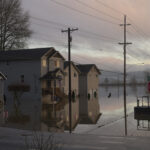If conditions remain unchanged, West Virginia faces the worst fire season in 20 years and could lose as much as 4 percent of its forests to flames.
The hottest, driest summer in recent memory has left a big chunk of West Virginia’s 11.8 million acres of forest dangerously dry heading into the fall fire season. There’s already been an outbreak of 100 or so fires across West Virginia.
Monday is the start of the fall fire season and the state Division of Forestry is bracing for the worst outbreak since 2,261 fires burned 428,810 acres in 1987. By comparison, about 887 fires burned more than 96,000 acres in 2001, West Virginia’s last bad year for fires.
“If history repeats itself and we do nothing different,” State Forester Randy Dye said, “we will burn 428,000 acres this fall.”
This year’s long string of 90-degree, sunny days is hurting more than the state’s vast forests, however. The state Department of Agriculture says hay harvests are down 30 percent or more in parts of the state and some water sources have run dry, forcing farmers to buy pricey feed, cull their herds or both.
The National Weather Service’s long-range forecast indicates there’s an equal chance West Virginia’s weather will stay above normal, moderate or turn cooler than usual.
If the temperatures stay up and rain continues to stay away, Dye said he may ask Gov. Joe Manchin to ban outdoor burning. Legal burning that gets out of hand is the leading cause of forest fires in the state. During the fall fire season, outdoor fires are permitted between 4 p.m. and 7 a.m.
“Let me say I’m very uneasy,” Dye said, “and know that I’m quite confident that our resources will be pushed to the edge of our abilities if the present conditions continue.”
Dye said the Forestry Division will use nonviolent prisoners and workers from other state agencies to fight fires, if necessary. Help from North Carolina, Georgia and other southern states also could be sought.
“They may have some resources available to assist us,” he said, noting that West Virginia sent fire crews to Georgia last year. “We help them when we can, and they help us when they’re able.”
Meanwhile, West Virginia farmers are turning even farther afield for help.
While feed is available, most of it is 800 to 1,000 miles away, in places like Kansas, because Kentucky and other nearby states have been hit by the same dry weather, said Dwayne O’Dell, assistant director of marketing for the Department of Agriculture Marketing and Development Division.
This year’s poor hay crop has left beef farmers with a choice of paying top dollar for feed or selling off more cattle than usual, O’Dell said.
Quality hay sells for between $130 and $160 a ton these days. Last year, hay averaged $110 a ton, according to the U.S. Department of Agriculture.
“It’s really kind of a Catch-22 for the farmer,” O’Dell said. “There is some feed available. The difficulty is, can he still remain profitable.”
Farmers who choose to reduce their herds face another problem. Normally, an influx of feeder calves hits the market from Labor Day through November. This year, that is happening a bit early and is accompanied by an influx of mature cows that, in many years, sell at the low end of the market, O’Dell said.
Was this article valuable?
Here are more articles you may enjoy.

 Abbott Presses Congress for Shield Over Preemie Baby Formula Litigation That Could Cost It Billions
Abbott Presses Congress for Shield Over Preemie Baby Formula Litigation That Could Cost It Billions  Pacific Northwest Braces for Even More Flooding Rain This Week
Pacific Northwest Braces for Even More Flooding Rain This Week  Rare Weather Warning Issued as Strong Gusts Fuel Colorado Wildfire Threats
Rare Weather Warning Issued as Strong Gusts Fuel Colorado Wildfire Threats  LA Fires Push Insurers’ 2025 Disaster Losses to $107 Billion
LA Fires Push Insurers’ 2025 Disaster Losses to $107 Billion 